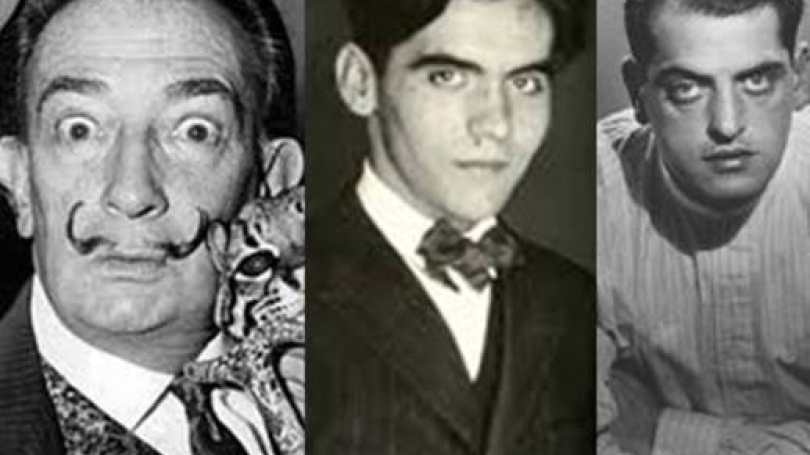
- About
- Undergraduate
- Foreign Study
- Student Opportunities
- La Casa
- News & Events
- People
Back to Top Nav
Back to Top Nav
Back to Top Nav
Back to Top Nav
Back to Top Nav
DALÍ, LORCA, AND BUÑUEL IN AMERICA: AN INTERNATIONAL CONFERENCE
Organized by José M. del Pino, Dartmouth Professor of Spanish
With the collaboration of Jill Baron, Librarian for Romance Languages & Literatures and Latin American Studies; Katherine W. Hart, Senior Curator of Collections- Barbara C. & Harvey P. Hood 1918 Curator of Academic Programming; and Sara Muñoz, Assistant Professor of Spanish.
SPONSORED BY THE HOOD MUSEUM OF ART, DEPARTMENT OF SPANISH AND PORTUGUESE, THE LESLIE CENTER FOR THE HUMANITIES, FRIENDS OF DARTMOUTH COLLEGE LIBRARY, OFFICE OF THE DEAN OF ARTS AND HUMANITIES, and with the support of Neukom DALI Lab (Digital Arts, Leadership, and Innovation Lab in Computer Science) at Dartmouth.
Dartmouth College, October 15-17, 2015
This international conference will explore the work of three major Spanish artists and their relationship with the United States. It will examine the dialogue among painting, literature and film during a foundational moment of the modernist and avant-garde period in Europe and America. Salvador Dalí (1904-1989), Federico García Lorca (1898-1936), and Luis Buñuel (1900-1983) were close friends during their formative years at the “Residencia de Estudiantes” in Madrid. The three friends became enthusiastic followers of the new artistic movements that dominated the international sphere, whose center during the 1920s was Paris. Although connected with the French avant-garde, they considered –and also feared– that the future of art resided not so much in Europe but in the United States —a nation that provoked in them both admiration and apprehension.
Lorca was the first one to visit New York in 1929. The result of his one-year trip was the creation of his influential collection of poems Poeta en Nueva York/Poet in New York (published posthumously as a book in México in 1940). Salvador Dalí visited New York and other parts of the United States in 1933 and 1936, returning to the country for a longer stay of several years in the 1940s. Dalí was able to apprehend the real and symbolic dimension of American popular culture, a dimension that he integrates into his innovative blend of surrealism and classicism. An icon of the unconventional nature of surrealism for the general public, Dalí recognized the complexities of the art market of his day profiting enormously from this realization. Buñuel, whose two films (in collaboration with Dalí) Un Chien andalou (1929) and L’Age d’Or (1930) had attained cult status within the European avant-garde, lived in New York and Los Angeles between 1938 and 1946. After working for the film department at the Museum of Modern Art (MOMA) and later for Warner Bros in Hollywood and because of the unclear prospect of continuing with his film career in the US, he decided to move to México with his family. In México (1946-1965), he became a successful film director and attained widespread international recognition.
Thursday, October 15 - Hood Auditorium
5:00 pm
Opening remarks.
5:15 pm
KEYNOTE ADDRESS
The Dr. Allen W. Root Contemporary Art Distinguished Lecture
"Travelling between the Avantgarde and Mass Culture: The American Journeys of Dalí, Lorca and Buñuel"
Antonio Monegal, Professor of Literary Theory and Comparative Literature, Universitat Pompeu Fabra- Barcelona
This talk and reception is co-sponsored by Friends of the Library, Dartmouth College
6:15 pm
Reception at Kim Gallery – Hood Museum (open to the public)
Friday, October 16 - Haldeman 041
First session: “Federico García Lorca: the impact of American culture and society in Poet in New York (85 years later)
Moderator: Raúl Bueno
9:30-10:00
“Lorca, Dalí, Buñuel and their contribution to the Hispanic Avant-garde”. Andrés Soria Olmedo (Universidad de Granada)
10:00-10:30
“Lorca in New York”. Christopher Maurer (Boston University)
Recess
10:45-11:15
“The adventures of a contentious manuscript: Poet in New York”. Andrew Anderson (University of Virginia)
11:15-12:00
Round table with respondent Carlos Ramos (Wellesley College)
Second session: “The embodiment of European surrealism: Salvador Dalí’s triumph in America
Moderator: José M. del Pino
3:00-3:30
“Dalí's Surrealist Discovery, Exploration and Conquest of America.” Carmen García de la Rasilla (University of New Hampshire)
3:30-4:00
“Dalí and American Culture in the 1940s.” Gisela Carbonell (The Baker Museum, Naples, FL)
Recess
4:15-4:45
"Dalí’s European Iconography." Begoña Souviron López (Universidad de Málaga)
4:45-5:15
"American Pop Culture in Dalí’s Art." Elliot H. King (Washington and Lee University)
5:15-5:45
Q&A
5:30-6:00
Opening of exhibit at Baker Library with Jill Baron.
7:00 - Hood Museum Auditorium
Screening of Un chien andalou and L’Age d’Or, followed by Destino and Viaje a la luna (for general public). Presented by Paul D. Young (Dartmouth College).
Saturday, October 17
Third session: Buñuel’s American exploits: the misadventures of a dissident filmmaker in the US and México
Moderator: Sara Muñoz - Haldeman 041
9:30-10:00
"The influence of US literature and film in Luis Buñuel." Fernando González de León (Springfield College, MA)
10:00-10:30
"Buñuel as a Mexican filmmaker and intellectual." Pedro Ángel Palou (Tuft University)
10:30-11:15
Round table on Buñuel with respondents Sara Muñoz and Antonio Monegal
Recess
11:30-12:30
“Lorca’s family in the US”. A conversation with Laura García-Lorca de los Ríos (Fundación Federico García Lorca, Madrid/Granada), followed by a reading of selected texts (participants and students)
Closing Remarks
3:30-4:15
Tour of Orozco Murals at Baker Library with Pedro Àngel Palou (optional)
To download this agenda, click here.